Introduction to Astronomy
The Terrestrial Planets
Planetary astronomy generally belongs, these days, to geologists, not astronomers. In order to understand it in detail, you would need a thorough background in geological processes or in atmospheric physics. In grade school, you already 'glossed over' the planets. So here, I constrain myself to telling you a few things about the planets that you may not know, and describing them to you with an eye to understanding planet formation, which is where the astronomy comes in!
Often, the solar system is portrayed in an image like this:
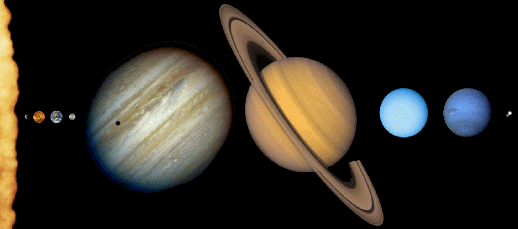 Which has the distinct disadvantage of showing all the planets close together (which they are not!), and on the same side of the Sun (which rarely happens!). However, if they did the whole thing to scale, so that the planets were the correct distances apart for their size, you'd never fit the whole thing in one picture. The Solar System is BIG. Really big. A lot. At least, it is BIG compared to the size of you and me!
Which has the distinct disadvantage of showing all the planets close together (which they are not!), and on the same side of the Sun (which rarely happens!). However, if they did the whole thing to scale, so that the planets were the correct distances apart for their size, you'd never fit the whole thing in one picture. The Solar System is BIG. Really big. A lot. At least, it is BIG compared to the size of you and me!
Mercury
Mercury is the closest planet to the Sun. Fundamentally, a big rock which has in the past been bombarded by other rocks that covered Mercury in craters. Frankly, I find Mercury to be a boring planet, although it CAN tell us about the conditions in the early solar system, which is interesting.
Venus
Venus is next in line. We've been to Venus a handful of times. Venus is quite close to the Earth in size, and comparable to the Earth in distance from the Sun (relatively speaking). And yet no one goes there to look for life. Why? Because Venus is a horrible place. It is so hot that lead is a liquid on the surface of Venus. The atmosphere is so thick, creating such high pressures at the surface that we have yet to make a spacecraft that can survive on the surface for more than a few minutes. It rains sulfuric acid on Venus. It's smelly and high pressure and very, very hot. There are three weird things about Venus that you should know.
1) You might think that Venus is hot because it is closer to the Sun than the Earth, but that is not the main reason for Venus' high surface temperature. The majority of Venus' atmosphere is made of greenhouse gases. So light gets into the atmosphere, and heats up the ground. But that heat can't radiate out into space. Instead, it gets trapped in the atmosphere, heating it up. This effectively acts like a big blanket, keeping the surface hot all the time. Scientists have nightmares about greenhouse gases because of Venus---the more greenhouse gases an atmosphere has, the more the planet becomes like Venus. Blech. This abundance of greenhouse gases is unusual, and should be explained.
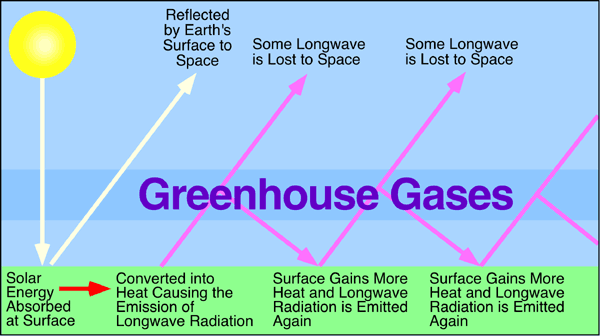 2) Venus counter-rotates very slowly, which is weird. The day is very long on Venus, and the Sun rises in the West, and sets in the East.
3) Venus' surface has been completely repaved in recent (astronomically speaking) history. It's as though the planet turned itself inside out, and the lava that used to be on the inside is now on the outside, erasing all evidence of prior craters, etc., that might have told us about the early history of Venus.
Why are all these important? Because they may all be related. If Venus was smashed into not long ago by an enormous planetoid, that may have flipped it over and slowed its rotation. At the same time, the impact would have ruptured the surface of the planet, releasing enormous lava flows, and liquifying the crust. This in turn would have released lots of nasty chemicals and greenhouse gases into the atmosphere, changing the atmosphere from whatever it was before into it's current hellish conditions. Is this true? How could we ever know!? But it does seem to make sense, and scientists spend time on these ideas so that someday we may find a way to figure out if we are right...
By a trick of geometry, we can sometimes see Venus having a phase, much like the Moon:
2) Venus counter-rotates very slowly, which is weird. The day is very long on Venus, and the Sun rises in the West, and sets in the East.
3) Venus' surface has been completely repaved in recent (astronomically speaking) history. It's as though the planet turned itself inside out, and the lava that used to be on the inside is now on the outside, erasing all evidence of prior craters, etc., that might have told us about the early history of Venus.
Why are all these important? Because they may all be related. If Venus was smashed into not long ago by an enormous planetoid, that may have flipped it over and slowed its rotation. At the same time, the impact would have ruptured the surface of the planet, releasing enormous lava flows, and liquifying the crust. This in turn would have released lots of nasty chemicals and greenhouse gases into the atmosphere, changing the atmosphere from whatever it was before into it's current hellish conditions. Is this true? How could we ever know!? But it does seem to make sense, and scientists spend time on these ideas so that someday we may find a way to figure out if we are right...
By a trick of geometry, we can sometimes see Venus having a phase, much like the Moon:
 From space, you can see only the atmosphere of Venus:
From space, you can see only the atmosphere of Venus:
 But we DO have radar maps of what the surface looks like:
But we DO have radar maps of what the surface looks like:
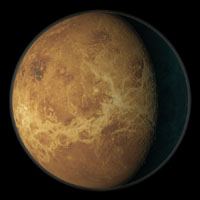 This is a particularly nice one, because it shows the whole planet! Notice the distinct lack of craters...
This is a particularly nice one, because it shows the whole planet! Notice the distinct lack of craters...
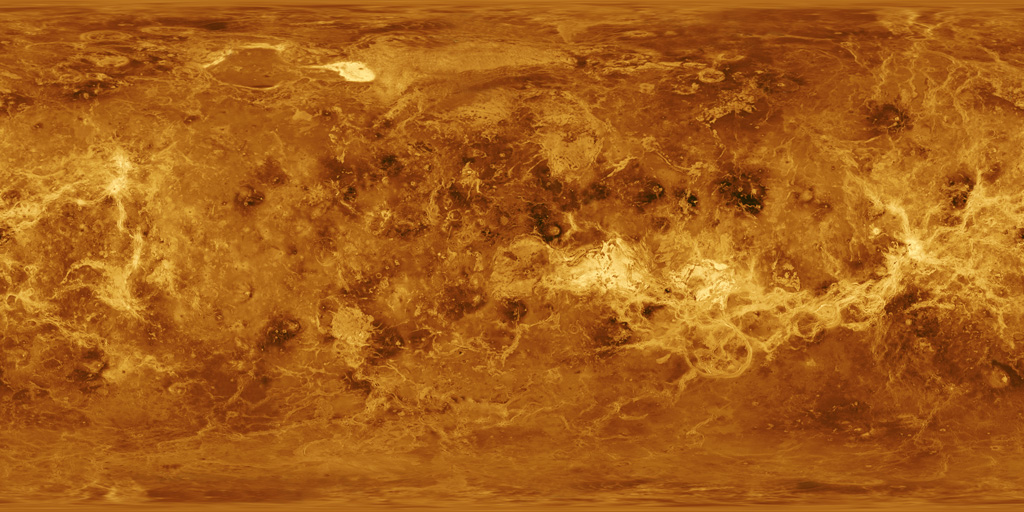 Here's a volcano on Venus. In this picture, the vertical scale has been exaggerated by 22.5 times. Because of the high pressure on Venus, even mountains tend to be somewhat flattened
Here's a volcano on Venus. In this picture, the vertical scale has been exaggerated by 22.5 times. Because of the high pressure on Venus, even mountains tend to be somewhat flattened
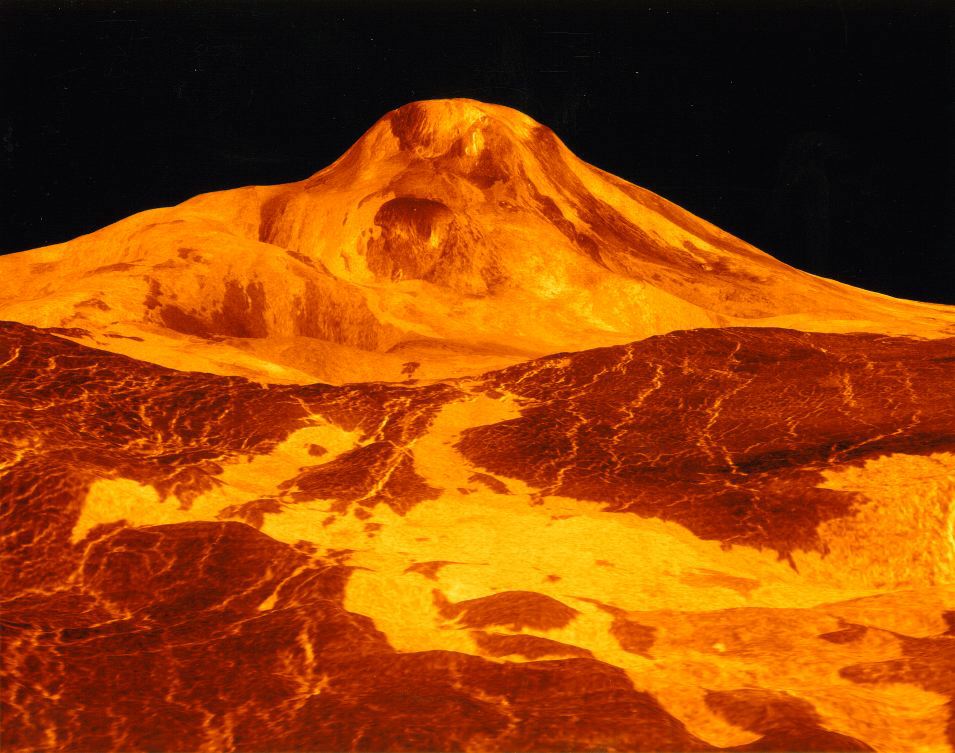 When the Soviets sent a probe to Venus, it took pictures of where it landed, but not for long. It was crushed like an empty pop can not long after landing!
When the Soviets sent a probe to Venus, it took pictures of where it landed, but not for long. It was crushed like an empty pop can not long after landing!
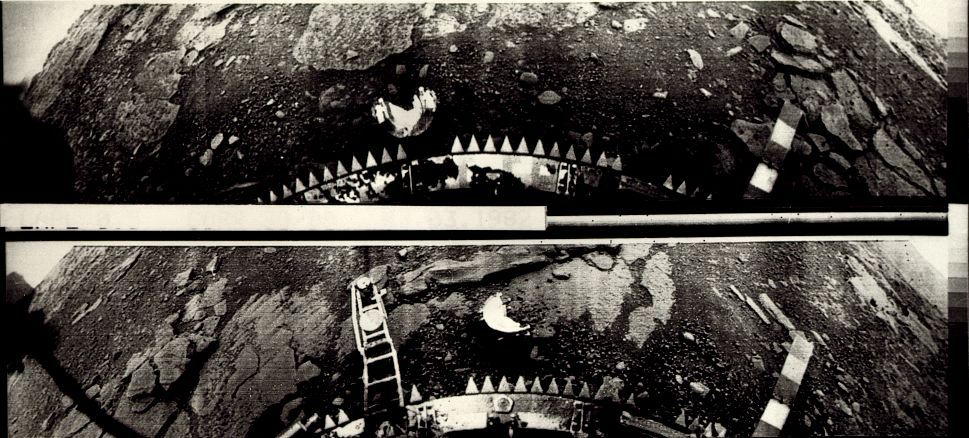
Earth
There is so much to know about the Earth that we have entirely different courses about it! For us, it is sufficient to know that
a) the Earth is the only KNOWN place with life. Sigh.
b) the Earth and the Moon are the only places man has ever set foot.
c) these two pictures changed EVERYTHING about the way man thinks about his home planet. It may be hard for you to imagine, but there was a time when we didn't know what the Earth looked like! Before we started the space program, we didn't know how small and fragile a place the Earth was. Some people knew it in their heads, but we didn't really UNDERSTAND until we saw these pictures. I know this, because I asked my grandpa about it.

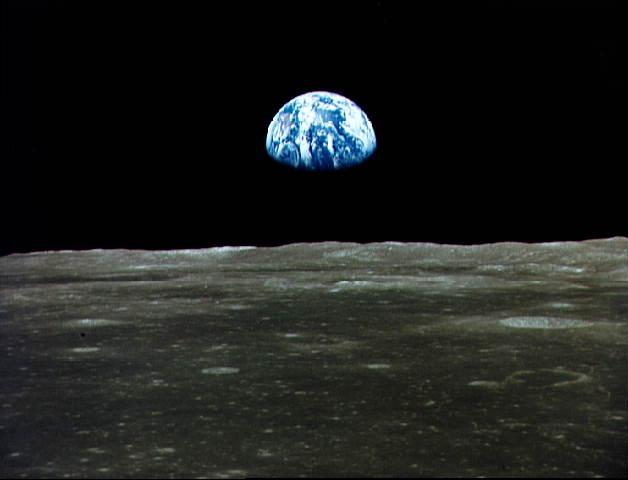
Mars
Mars is everybody's favorite planet for visiting. The length of the day is not so very different from the Earth's, the year is not so different from the Earth's. The planet is only about half the size of the Earth, but that seems manageable.
Still, it's cold, and dry, and not really hospitable. Why are we so fascinated? Because it's the closest place to the Earth that might (either now or in the past) harbor life. There is really good evidence that Mars may have had flowing water in the past, and that there is water locked up there currently. This is good, since we think that life needs water to exist.
Man has never been to Mars, however, so we haven't yet figured out for sure what the situation is. There are some nuts (and I meant that in the nicest possible way!) who REALLY, REALLY, REALLY want to go to Mars. I mean REALLY.
You can find out about them at, for example, The Mars Society. They even have a station in the Utah desert! You can even go work there, for no money! Crazy nuts. I love them. We'd never get anything done if it wasn't for nutty nuts!
Mars is pretty cool in its own right, questions of life aside. Here are some pretty pictures.

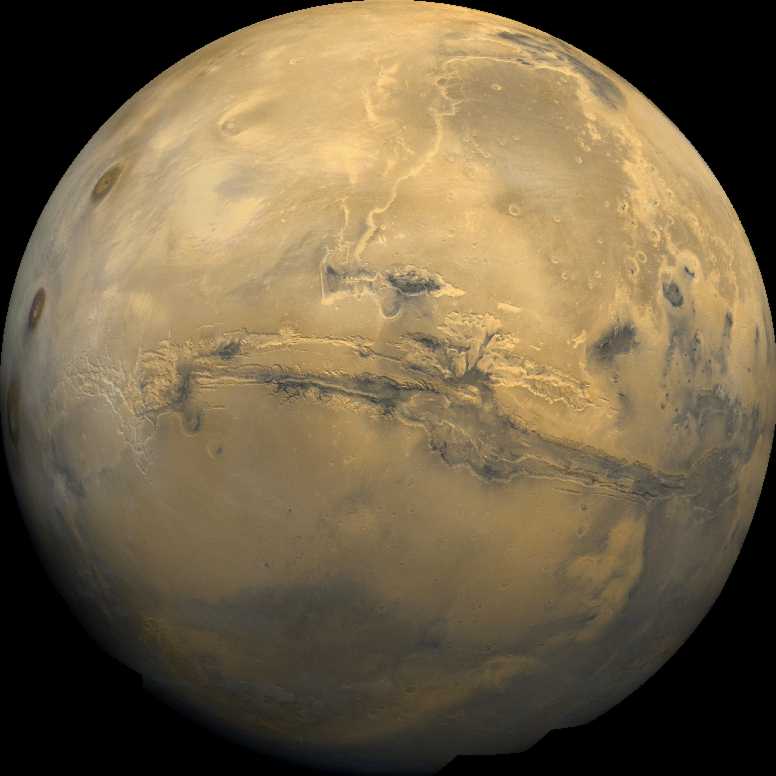
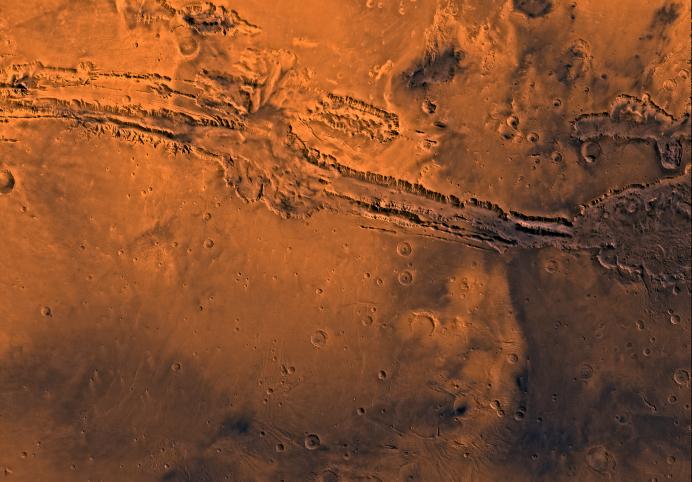


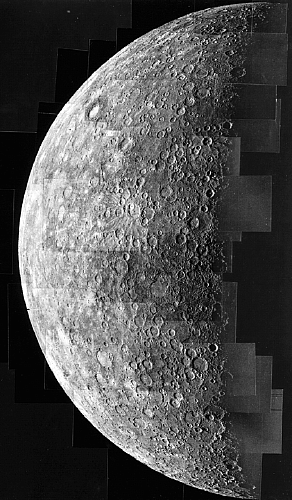
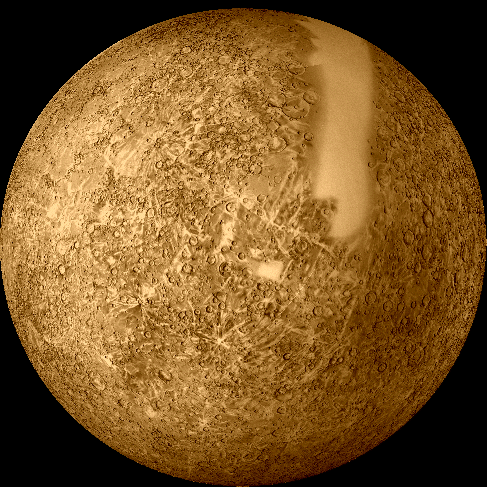





























 Which has the distinct disadvantage of showing all the planets close together (which they are not!), and on the same side of the Sun (which rarely happens!). However, if they did the whole thing to scale, so that the planets were the correct distances apart for their size, you'd never fit the whole thing in one picture. The Solar System is BIG. Really big. A lot. At least, it is BIG compared to the size of you and me!
Which has the distinct disadvantage of showing all the planets close together (which they are not!), and on the same side of the Sun (which rarely happens!). However, if they did the whole thing to scale, so that the planets were the correct distances apart for their size, you'd never fit the whole thing in one picture. The Solar System is BIG. Really big. A lot. At least, it is BIG compared to the size of you and me!
 2) Venus counter-rotates very slowly, which is weird. The day is very long on Venus, and the Sun rises in the West, and sets in the East.
3) Venus' surface has been completely repaved in recent (astronomically speaking) history. It's as though the planet turned itself inside out, and the lava that used to be on the inside is now on the outside, erasing all evidence of prior craters, etc., that might have told us about the early history of Venus.
Why are all these important? Because they may all be related. If Venus was smashed into not long ago by an enormous planetoid, that may have flipped it over and slowed its rotation. At the same time, the impact would have ruptured the surface of the planet, releasing enormous lava flows, and liquifying the crust. This in turn would have released lots of nasty chemicals and greenhouse gases into the atmosphere, changing the atmosphere from whatever it was before into it's current hellish conditions. Is this true? How could we ever know!? But it does seem to make sense, and scientists spend time on these ideas so that someday we may find a way to figure out if we are right...
By a trick of geometry, we can sometimes see Venus having a phase, much like the Moon:
2) Venus counter-rotates very slowly, which is weird. The day is very long on Venus, and the Sun rises in the West, and sets in the East.
3) Venus' surface has been completely repaved in recent (astronomically speaking) history. It's as though the planet turned itself inside out, and the lava that used to be on the inside is now on the outside, erasing all evidence of prior craters, etc., that might have told us about the early history of Venus.
Why are all these important? Because they may all be related. If Venus was smashed into not long ago by an enormous planetoid, that may have flipped it over and slowed its rotation. At the same time, the impact would have ruptured the surface of the planet, releasing enormous lava flows, and liquifying the crust. This in turn would have released lots of nasty chemicals and greenhouse gases into the atmosphere, changing the atmosphere from whatever it was before into it's current hellish conditions. Is this true? How could we ever know!? But it does seem to make sense, and scientists spend time on these ideas so that someday we may find a way to figure out if we are right...
By a trick of geometry, we can sometimes see Venus having a phase, much like the Moon:
 From space, you can see only the atmosphere of Venus:
From space, you can see only the atmosphere of Venus:
 But we DO have radar maps of what the surface looks like:
But we DO have radar maps of what the surface looks like:
 This is a particularly nice one, because it shows the whole planet! Notice the distinct lack of craters...
This is a particularly nice one, because it shows the whole planet! Notice the distinct lack of craters...
 Here's a volcano on Venus. In this picture, the vertical scale has been exaggerated by 22.5 times. Because of the high pressure on Venus, even mountains tend to be somewhat flattened
Here's a volcano on Venus. In this picture, the vertical scale has been exaggerated by 22.5 times. Because of the high pressure on Venus, even mountains tend to be somewhat flattened
 When the Soviets sent a probe to Venus, it took pictures of where it landed, but not for long. It was crushed like an empty pop can not long after landing!
When the Soviets sent a probe to Venus, it took pictures of where it landed, but not for long. It was crushed like an empty pop can not long after landing!






